
views
Finding Your Highest & Lowest Notes

First, warm up your voice for a few minutes. Warming up helps you “wake up” your vocal cords, focus on your breathing, and improve the flexibility of your voice (making it easier to hit the extreme low and high notes of your range). No need for flashy technical exercises—try some of these simple warmups:Sighs: Inhale with your mouth closed, then “sigh” through your nose, allowing your vocal cords to make a soft “yawning” sound.Lip buzzing: Inhale through your mouth, then exhale with your lips held loosely together so they “flap” in the air stream (like you’re mimicking a motorcycle sound). Descending mini-scales: Start in your head (falsetto) voice and sing 5-note scales going downward on a relaxed, open syllable like “ah” or “oo.” Repeat several times, starting on a lower pitch each time.Body stretches: If it’s first thing in the morning, stretch your neck, back, and shoulders to get physically comfortable. This helps you breathe deeply and support your singing voice.
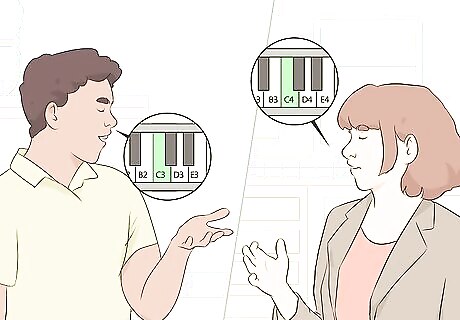
Sing and play an easy note in the middle of your range on a keyboard. This will be your starting point for exploring your range. For many women, playing middle C (C4) is a good place to start. For men, try an octave lower on C3. Sing on an open, comfortable syllable like “ah” or “oo.” On a full-size (88 key) keyboard, middle C is the 24th white key from the left (the 4th C from the left).If you don’t have access to a piano or keyboard, download a piano app like Virtual Piano + instead.
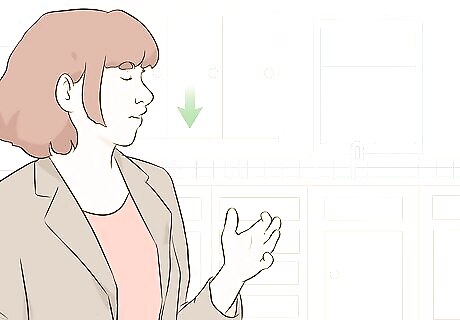
Sing down, note by note, until you can’t sustain the pitch comfortably. Stop on the lowest note you can sustain in your normal, comfortable voice for about 3 seconds without croaking or cracking. This is the lowest note of your chest voice (your normal or “modal” voice). Vocal therapist Amy Chapman says, “You should not have to “breathe” the note. Its tone quality should match the rest of your chest voice and not have a breathy or scratchy sound.”Once you know how low your voice reaches comfortably, try to go a bit lower. Amy Chapman says, “Breathy notes you can sustain for 3 seconds count for this “extended” range, but croaky notes that you cannot hold do not.” For some singers, their lowest normal and breathy notes may coincide. For others, they might not.

Record your lowest comfortable note and lowest “breathy” note. Write down the letter name of the note (A, B, C, D, E, F, or G) followed by a number that matches which octave the note is in. For example, if your lowest note is the second-to-last E on the keyboard (the second E from the left), write down E2 because it’s in the second octave of the piano.Remember that the first 2 white keys on the left (A and B) are in octave 0. Octave 1 starts at the first C (C1, or the 3rd white key from the left).
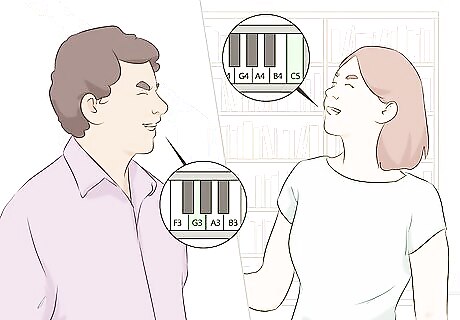
Repeat this process going upward to find your highest notes. Go back to your starting pitch and sing upward with the keyboard. Stop at the highest note you can sing in your chest voice for 3 seconds, but “do not let yourself go into falsetto for this exercise,” says vocal therapist Amy Chapman. If you hear a break or new breathiness in your voice, then you’ve passed into your falsetto range. Once you’ve found your highest note in chest voice, relax your vocal cords and push yourself higher. Amy Chapman says, “Use your breathier, flute-like falsetto voice to find the highest notes you can reach without straining or cracking.”Write down both your highest modal and falsetto notes.
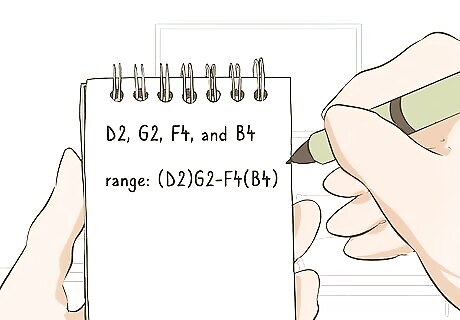
Write down your 2 lowest and 2 highest notes in ascending order. Put parentheses around the lowest “breathy” note and your highest falsetto note, and a dash between the middle two notes representing your chest voice. This notation expresses your full vocal range—your extremes low and high, plus your “normal” comfortable range. For example, your full range might look like (D2)G2–F4(B4).
Matching Your Range to a Voice Type

Your most comfortable singing range is called your tessitura. For most singers, this is their chest voice, or the part of the voice that feels the most natural and has the best, fullest tone most of the time. It’s where your voice naturally wants to “sit.”Your tessitura is represented by the middle pitches in your 4-note range notation (your lowest and highest chest voice notes, not including your falsetto or breathy low notes).Knowing your tessitura helps determine your voice type and choose music that fits your voice. Training or singing outside of your tessitura too often (singing music sits too high or low for your voice) can lead to vocal strain or damage over time.
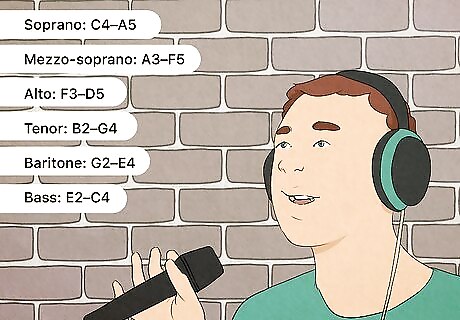
Compare your tessitura and full range to the ranges of standard voice types. If your full range doesn’t fit perfectly into a single voice type, use your tessitura to see which type it most closely aligns with and choose the type that fits the closest. Here are the major voice types and their approximate ranges:Soprano: C4–A5. This is the highest female voice type.Mezzo-soprano: A3–F5. This is the middle female voice type.Alto: F3–D5. This is the lowest female voice type.Tenor: B2–G4. This is the highest male voice type.Baritone: G2–E4. This is the middle male voice type.Bass: E2–C4. This is the lowest male voice type.For example, if you have a range of (D2)G2–F4(A4), you would most likely be a baritone, the most common voice type for men. EXPERT TIP Amy Chapman, MA Amy Chapman, MA Vocal Coach Amy Chapman MA, CCC-SLP is a vocal therapist and singing voice specialist. Amy is a licensed and board certified speech & language pathologist who has dedicated her career to helping professionals improve and optimize their voice. Amy has lectured on voice optimization, speech, vocal health, and voice rehabilitation at universities across California, including UCLA, USC, Chapman University, Cal Poly Pomona, CSUF, CSULA. Amy is trained in Lee Silverman Voice Therapy, Estill, LMRVT, and is a part of the American Speech and Hearing Association. Amy Chapman, MA Amy Chapman, MA Vocal Coach Did You Know? On any day, your voice might be a couple of notes higher or lower. It can vary due to illness, fatigue, or laryngitis.
The Vocal Registers
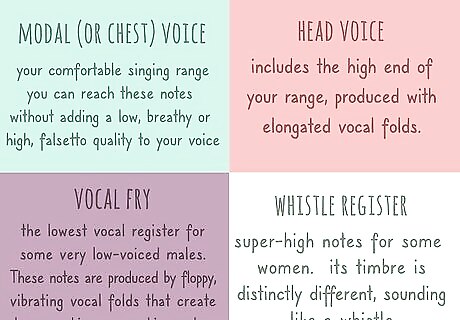
Each register (a range or group of notes) of your voice has a distinct timbre (tone quality) and is produced by a different action of your vocal cords. This is what makes your low notes sound different from your high notes. Knowing where your registers lay in your range can help you choose songs or decide how you want your voice to sound in places where the registers overlap. Chest (modal) voice: This is your most comfortable singing range (tessitura) where the vocal folds are relaxed and the sound resonates in your chest. These are the notes you can reach without straining or flipping into falsetto.Head voice: This includes the high end of your range, produced with elongated vocal folds. These notes resonate in your head and have a distinct “ringing” quality. Your head voice begins after the “break” in your voice at the high end of your chest voice. Your falsetto voice is a bit lighter and breathier and is included as part of your head voice.Vocal fry: This is the lowest vocal register where notes are produced by floppy, vibrating vocal folds that create low, creaking or croaking notes. Only some very low-voiced men can reach this range.Whistle register: This is an extension of the head voice available to some very high-voiced women. These notes can sound more like a whistle than a human voice (think Mariah Carey’s or Ariana Grande’s super high notes).
How many octaves is your range?

Every group of 8 white piano keys within your range is 1 octave. Using a keyboard, count the notes (white keys only) between the lowest note you could sing and the highest. Every eight notes (the distance from one note to the next note with the same name, like A to A) is one octave. The 8th note will also count as the 1st note of the next octave. For example, if your lowest note was E2 and your highest note was E4, then you have a range of two octaves (E2 to E3 is 8 white keys, and E3 to E4 is another 8 white keys).Include partial octaves as well. If your lowest note is E2 and your highest is B4 (just 4 more notes into the next octave), you’d say you have 2.5 octaves.Acoustically, an octave is the interval between 2 notes where the top note has twice the sound frequency of the bottom note. For example, A4 is 440 Hz and A5 (one octave higher) is 880 Hz. Notes that are an octave apart will have the same letter name.If you’re unsure how to count octaves yourself, use an online octave calculator. Just plug in your lowest and highest notes to find out!
What’s Scientific Pitch Notation?
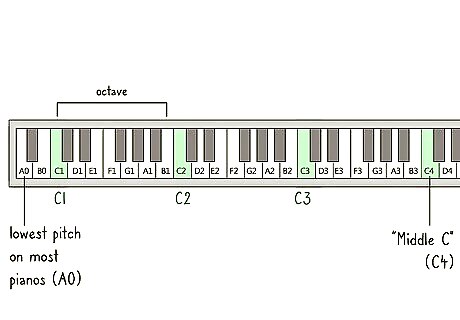
Scientific Pitch Notation (SPN) is the standard way of writing and understanding musical notes using letters (to identify the notes A through G) and numbers (to identify the octave the note is in). The lowest note on a full piano keyboard is A0. The highest note is C8.The first, lowest octave begins on C1, or the first “C” on the keyboard. This is because the C major scale uses only the white notes of the keyboard, making octave identification easier.Non-C notes get their octave designation from the C below them. For example, the E above C4 is E4.The first 2 white keys (“A” and “B”) are in octave 0 because they come before C1.



















Comments
0 comment